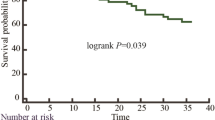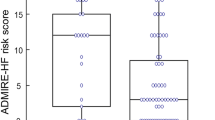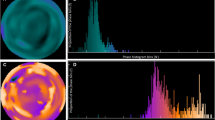Abstract
Background
The use of left ventricular mechanical dyssynchrony (LVMD), which has been reported to be responsible for unfavorable outcomes, might improve conventional risk-stratification by clinical indices including QRS duration (QRSd) and systolic dysfunction in patients with heart failure (HF).
Methods and results
Following measurements of 12-lead QRSd and left ventricular ejection fraction (LVEF), three-dimensional (3-D) LVMD was evaluated as a standard deviation (phase SD) of regional mechanical systolic phase angles by gated myocardial perfusion imaging in 829 HF patients. Patients were followed up for a mean period of 37 months with a primary endpoint of lethal cardiac events (CEs). In an overall multivariate Cox proportional hazards model, phase SDs were identified as significant prognostic determinants independently. The patients were divided into 4 groups by combining with the cut-off values of LVEF (35% and 50%) and QRSd (130 ms and 150 ms). The groups with lower LVEF and prolonged QRSd more frequently had CEs than did the other groups. Patient groups with LVEF < 35% and with 35% ≦ LVEF < 50% were differentiated into low-risk and high-risk categories by using an optimal phase SD cut-off value of both QRSd thresholds.
Conclusions
3-D LVMD can risk-stratify HF patients with mid-range as well as severe abnormalities of QRSd and systolic dysfunction.






Similar content being viewed by others
Abbreviations
- LVMD:
-
Left ventricular mechanical dyssynchrony
- QRSd:
-
QRS duration
- HF:
-
Heart failure
- NYHA:
-
New York Heart Association
- LVEF:
-
Left ventricular ejection fraction
- CRT:
-
Cardiac resynchronization therapy
- ICD:
-
Implantable cardioverter defibrillator
- Hb:
-
Hemoglobin
- BNP:
-
Brain natriuretic peptide
- eGFR:
-
Estimated glomerular filtration rate
References
Epstein AE, DiMarco JP, Ellenbogen KA, Estes NA, Freedman RA, Gettes LS, et al. American College of Cardiology Foundation; American Heart Association Task Force on Practice Guidelines; Heart Rhythm Society. 2012 ACCF/AHA/HRS Focused Update Incorporated Into the ACCF/AHA/HRS 2008 Guidelines for Device-Based Therapy of Cardiac Rhythm Abnormalities. J Am Coll Cardiol 2013;61:e6-75.
Ponikowski P, Voors AA, Anker SD, Bueno H, Cleland JGF, Coats AJS, et al. 2016 ESC Guidelines for the diagnosis and treatment of acute and chronic heart failure. Eur Heart J. 2016;37:2129-200.
Tsutsui H, Isobe Mitsuaki, Ito Hiroshi, Okumura Ken, Ono Minoru, Kitakaze Masafumi, et al. Guidelines for diagnosis and treatment of acute and chronic heart failure. Circ J 2019;83:2084-184.
Abraham WT, Fisher WG, Smith AL, Delurgio DB, Leon AR, Loh E, et al. Cardiac resynchronization in chronic heart failure. N Engl J Med 2002;346:1845-53.
Fox DJ, Fitzpatrick AP, Davidson NC. Optimisation of cardiac resynchronisation therapy: Addressing the problem of ‘non-responders’. Heart 2005;91:1000-2.
Chung ES, Leon AR, Tavazzi L, Sun PG, Nihoyannopoulos P, Merlino J, et al. Results of the predictors of response to crt (prospect) trial. Circulation 2008;117:2608-16.
Hawkins NM, Petrie MC, Burgess MI, McMurray JJ. Selecting patients for cardiac resynchronization therapy: the fallacy of echocardiographic dyssynchrony. J Am Coll Cardiol 2009;53:1944-59.
Chen J, Henneman MM, Trimble MA, Borges-Neto S, Iskandrian AE, et al. Assessment of left ventricular mechanical dyssynchrony by phase analysis of ECG-gated SPECT myocardial perfusion imaging. J Nucl Cardiol 2008;15:127-36.
Wang L, Yang MF, Cai M, Zhao SH, He ZX, Wang YH, et al. Prognostic significance of left ventricular dyssynchrony by phase analysis of gated SPECT in medically treated patients with dilated cardiomyopathy. Clin Nucl Med 2013;38:510-5.
Zafrir N, Nevzorov R, Bental T, Strasberg B, Gutstein A, Mats I, et al. Prognostic value of left ventricular dyssynchrony by myocardial perfusion-gated SPECT in patients with normal and abnormal left ventricular functions. J Nucl Cardiol 2014;21:532-40.
Nakajima K, Okuda K, Matsuo S, Kiso K, Kinuya S, Gracia EV, et al. Comparison of phase dyssynchrony analysis using gated myocardial perfusion imaging with four software programs: Based on the Japanese Society of Nuclear Medicine working group normal database. J Nucl Cardiol 2017;24:611-21.
Doi T, Nakata T, Yuda S, Hashimoto A. Synergistic prognostic implications of left ventricular mechanical dyssynchrony and impaired cardiac sympathetic nerve activity in heart failure patients with reduced left ventricular ejection fraction. Eur Heart J Cardiovasc Imaging 2018;19:74-83.
Doai T, Nakata T, Yuda S, Hashimoto A. Synergistic prognostication of left ventricular hypertrophy and three-dimensional mechanical dyssynchrony in heart failure. ESC Heart Fail 2020;7:361-70.
Bertaglia E, Reggiani A, Palmisano P, D’Onofrio A, Simone AD, Caico SI, et al. The stricter criteria for Class I CRT indication suggested by the 2016 ESC Guidelines reliably exclude patients with a worse prognosis in comparison with the 2013 ESC indication criteria. Int J Cardiol 2018;273:162-7.
D’Andrea A, Mele D, Nistri S, Riegler L, Galderisi M, Agricola E, et al. The prognostic impact of dynamic ventricular dyssynchrony in patients with idiopathic dilated cardiomyopathy and narrow QRS. Eur Heart J Cardiovasc Imaging 2013;14:183-9.
Wang NC, Maggioni AP, Konstam MA, Zannad F, Krasa HB, Burnett JC Jr, et al. Efficacy of Vasopressin Antagonism in Heart Failure Outcome Study With Tolvaptan (EVEREST) Investigators: Clinical implications of QRS duration in patients hospitalized with worsening heart failure and reduced left ventricular ejection fraction. JAMA 2008;299:2656-66.
Bacharova L, Szathmary V, Potse M, Mateasik A. Computer simulation of ECG manifestations of left ventricular electrical remodeling. J Electrocardiol 2012;45:630-4.
Carità P, Corrado E, Pontone G, Curnis A, Bontempi L, Novo G, et al. Non-responders to cardiac resynchronization therapy: Insights from multimodality imaging and electrocardiography. A brief review. Int J Cardiol 2016;225:402-7.
Bax JJ, Delgado V, Sogaard P, Singh JP, Abraham WT, Borer JS, et al. Prognostic implications of left ventricular global longitudinal strain in heart failure patients with narrow QRS complex treated with cardiac resynchronization therapy: A subanalysis of the randomized EchoCRT trial. Eur Heart J 2017;38:720-6.
Shah RM, Patel D, Molnar J, Ellenbogen KA, Koneru JN, et al. Cardiac-resynchronization therapy in patients with systolic heart failure and QRS interval ≤ 130 ms: Insights from a meta-analysis. Europace 2015;17:267-73.
Ruschitzka F, Abraham WT, Singh JP, Bax JJ, Borer JS, Brugada J, et al. EchoCRT Study Group: Cardiac-resynchronization therapy in heart failure with a narrow QRS complex. N Engl J Med 2013;369:1395-405.
Zweerink A, van Everdingen WM, Nijveldt R, Salden OA, Meine M, Maass AH, et al. Strain imaging to predict response to cardiac resynchronization therapy: A systematic comparison of strain parameters using multiple imaging techniques. ESC Heart Fail 2018;5:1130-40.
Fulati Z, Liu Y, Sun N, Kang Y, Su Y, Chen H, et al. Speckle tracking echocardiography analyses of myocardial contraction efficiency predict response for cardiac resynchronization therapy. Cardiovasc Ultrasound 2018;16:30.
Acknowledgements
The authors sincerely thank the staff of Nuclear Medicine Laboratory, Teine-Ki**nkai Hospital (Sapporo), Hokkaido, Japan for their clinical services and their technical assistance.
Author information
Authors and Affiliations
Corresponding author
Ethics declarations
Disclosures
Conflict of interest to be declared for the study.
Additional information
Publisher's Note
Springer Nature remains neutral with regard to jurisdictional claims in published maps and institutional affiliations.
Funding: There was no specific funding.
The authors of this article have provided a PowerPoint file, available for download at SpringerLink, which summarises the contents of the paper and is free for re-use at meetings and presentations. Search for the article DOI on SpringerLink.com.
Supplementary Information
Below is the link to the electronic supplementary material.
Rights and permissions
About this article
Cite this article
Doi, T., Nakata, T., Noto, T. et al. Improved risk-stratification in heart failure patients with mid-range to severe abnormalities of QRS duration and systolic function using mechanical dyssynchrony assessed by myocardial perfusion-gated SPECT. J. Nucl. Cardiol. 29, 1611–1625 (2022). https://doi.org/10.1007/s12350-021-02554-5
Received:
Accepted:
Published:
Issue Date:
DOI: https://doi.org/10.1007/s12350-021-02554-5




